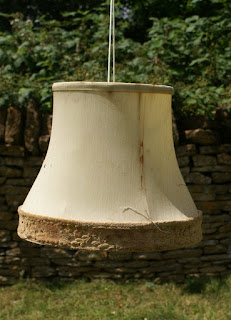It is my intention to share useful handy tips and wrinkles (as doris would say) to fellow lampshade makers, especially those still getting the hang of this most rewarding craft. The plan is to start by working step-by-step through a handmade tailored silk shade trimmed with handmade frills. As it's been a busy few days in the Shed, this happy shade is still on the workbench so I've decided to share a little number already tucked up my sleeve...
'Jenny Wren' was first created for Tend magazine. It is quite original, in that no-one to the best of my knowledge has ever created an inside out shade. Indeed it is one of my trade mark shades (and so it goes without saying that it should only be made for personal enjoyment). A little lampshading experience will stand you in good stead, however even utmost beginners can join in and create a beautiful and impressive 'bird cage' Jenny Wren by just wrapping the frame in bright fabrics.
As this project is quite involved, I have decided to split it into two posts. Here is...
How to make your Jenny Wren Lampshade: Part One
You will need:
An old lampshade frame
Fabrics for the cover and to make binding strips (lightweight cottons and linens are ideal)
Berry-headed pins
UHU glue
Old sheeting to make the template
Cotton jersey lining fabric (optional)
Strong sewing thread, needle and scissors
Clip-on birds, butterflies, flowers or other lovelies
1. Start with a tatty old shade. Any shape will do as long as you love it. Use old scissors to strip of the old fabric and a blunt edge to scrape off any glue. My shade is an oval 'banded' empire, which means it has an extra ring around the bottom edge... great for perching on.
2. Choose your fabric. The cover is a patchwork of panels, so make the most of treasured scraps. Choose fabric of a similar weight and character, with similar stretch when pulled on the bias. I combined various scraps of vintage sheeting with a little bit of embroidered table linen. It was all looking rather polite so I threw strong shades of silk into the mix for binding.
3. Rust has a habit of creeping through so paint your shade frame with a quality primer of stain block.
3. Rust has a habit of creeping through so paint your shade frame with a quality primer of stain block.
4. Now bind your frame with strips of fabric. This all-engrossing job can take a couple of evenings. Start by cutting your fabric into 1in (2.5cm) wide strips on the bias. Bias-cut strips bind neatly and fray less.
Bind the verticals first, wrapping around the top ring to start off, securing with a dab of UHU and a pin. Fold the trailing edge of the strip under to hide the raw edge and wrap, keeping it constantly tight and evenly bound. It takes a while to get the knack, so don’t feel too bad if you have to undo the first one. Once you get the hang of it, try combining two colours to create a candy stripe.
Once all the verticals are bound, bind the top and bottom rings, hiding all the raw ends as you go. Finish with your end at the back of the ring, fixed with a dab of UHU or a stitch.
At this stage if you wish you can attach a pretty handmade accessory and stand back to admire your work. If you'd like to carry on and make the complete Jenny Wren shade this is what's in store next week…
Making the template, sewing and stretching on the cover. Happy frame binding xx







No comments:
Post a Comment
oo yes... do let me know what you think. i'll endeavour to write back to each and every one :-)